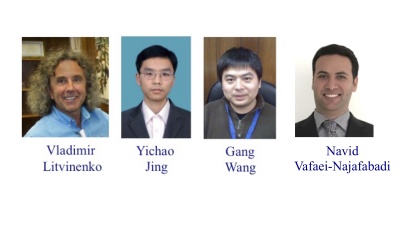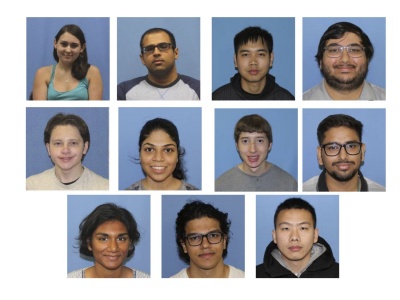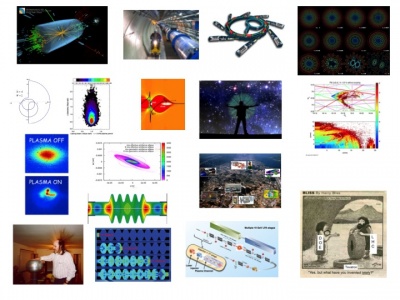Difference between revisions of "PHY554 spring 2020"
(→List of suggested projects) |
(→Homeworks) |
||
| (12 intermediate revisions by 2 users not shown) | |||
| Line 90: | Line 90: | ||
== Lecture Notes == | == Lecture Notes == | ||
| − | * [[media:PHY554_Lecture_1_compressed.pdf|PHY554 Lecture 1, Modern Accelerators]], by Prof. | + | * [[media:PHY554_Lecture_1_compressed.pdf|PHY554 Lecture 1, Modern Accelerators]], by Prof. V.N. Litvinenko |
| − | * [[media:PHY554_Lectures_2&3_VL-comp.pdf|PHY554 Lectures 2 and 3, History of Accelerators]], by Prof. | + | * [[media:PHY554_Lectures_2&3_VL-comp.pdf|PHY554 Lectures 2 and 3, History of Accelerators]], by Prof. V.N. Litvinenko |
| − | * [[media:Matrix_calculus_refresher.pdf|Matrix calculus refresher]], by Prof. | + | * [[media:Matrix_calculus_refresher.pdf|Matrix calculus refresher]], by Prof. V.N. Litvinenko |
* [[media:1.pdf|PHY554 Lecture 4, Transverse (Betatron) Motion]], by Prof. Y. Jing | * [[media:1.pdf|PHY554 Lecture 4, Transverse (Betatron) Motion]], by Prof. Y. Jing | ||
* [[media:2.pdf|PHY554 Lecture 5, Floquet Theorem, Phase space]], by Prof. Y. Jing | * [[media:2.pdf|PHY554 Lecture 5, Floquet Theorem, Phase space]], by Prof. Y. Jing | ||
| Line 98: | Line 98: | ||
* [[media:4.pdf|PHY554 Lecture 7, Off-momentum particles, dispersion function]], by Prof. Y. Jing | * [[media:4.pdf|PHY554 Lecture 7, Off-momentum particles, dispersion function]], by Prof. Y. Jing | ||
* [[media:5.pdf|PHY554 Lecture 8, Quadrupole field errors]], by Prof. Y. Jing | * [[media:5.pdf|PHY554 Lecture 8, Quadrupole field errors]], by Prof. Y. Jing | ||
| − | * [[media:PHY554_Lecture_9_VL.pdf|PHY554 Lecture 9, Introduction to RF accelerators]], by Prof. | + | * [[media:PHY554_Lecture_9_VL.pdf|PHY554 Lecture 9, Introduction to RF accelerators]], by Prof. V.N. Litvinenko |
| − | * [[media:PHY554_Lecture_10_2020.pdf|PHY554 Lecture 10, Fundamentals of RF accelerators]], by Prof. | + | * [[media:PHY554_Lecture_10_2020.pdf|PHY554 Lecture 10, Fundamentals of RF accelerators]], by Prof. V.N. Litvinenko |
| − | * [[media:PHY554_Lecture_11_2020.pdf|PHY554 Lecture 11, Superconducting RF accelerators and ERLs]], by Prof. | + | * [[media:PHY554_Lecture_11_2020.pdf|PHY554 Lecture 11, Superconducting RF accelerators and ERLs]], by Prof. V.N. Litvinenko |
| − | * [[media:PHY554_Lectures_12_2020.pptx|PHY554 Lecture 12, Longitudinal beam dynamics, Power Point with animations]], by Prof. | + | * [[media:PHY554_Lectures_12_2020.pptx|PHY554 Lecture 12, Longitudinal beam dynamics, Power Point with animations]], by Prof. V.N. Litvinenko |
| − | * [[media:PHY554_Lectures_12_VL_compressed.pdf |PHY554 Lecture 12, Longitudinal beam dynamics, PDF]], by Prof. | + | * [[media:PHY554_Lectures_12_VL_compressed.pdf |PHY554 Lecture 12, Longitudinal beam dynamics, PDF]], by Prof. V.N. Litvinenko |
| − | * [[media:PHY554_Lecture_13__2020.pdf|PHY554 Lecture 13, Beam Dynamics in an Electron Storage Ring]], by Prof. | + | * [[media:PHY554_Lecture_13__2020.pdf|PHY554 Lecture 13, Beam Dynamics in an Electron Storage Ring]], by Prof. V.N. Litvinenko |
* [[media:6.pdf|PHY554 Lecture 14, Chromaticities, its correction and simplectic integration]], by Prof. Y. Jing | * [[media:6.pdf|PHY554 Lecture 14, Chromaticities, its correction and simplectic integration]], by Prof. Y. Jing | ||
* [[media:7.pdf|PHY554 Lecture 16, Nonlinear Dynamics]], by Prof. Y. Jing | * [[media:7.pdf|PHY554 Lecture 16, Nonlinear Dynamics]], by Prof. Y. Jing | ||
| Line 112: | Line 112: | ||
* [[media:PHY554_Lecture_20_2020_1.pdf|PHY554 Lectures 20, Collective effects and instabilities II]], by Prof. G. Wang | * [[media:PHY554_Lecture_20_2020_1.pdf|PHY554 Lectures 20, Collective effects and instabilities II]], by Prof. G. Wang | ||
* [[media:PHY554_Lecture_21.pdf|PHY554 Lectures 21, Free Electron Lasers]], by Prof. G. Wang | * [[media:PHY554_Lecture_21.pdf|PHY554 Lectures 21, Free Electron Lasers]], by Prof. G. Wang | ||
| − | + | * [[media:PHY554_Lecture_23_2018.pdf|PHY554 Lectures 22-23, Hadron Cooling]], by Prof. G. Wang | |
| − | + | * [[media:SC_test.txt|matlab script to test stochastic cooling, change the file name to SC_test.m]], by Prof. G. Wang | |
| − | + | * [[media:PHY_554_Lecture_24_compressed.pdf|PHY554 Lectures 24, Advanced Acceleration Methods]], by Prof. N. Vafaei-Najafabadi | |
| − | + | * [[media:PHY554_Lectures_25_26_comp.pdf |PHY554 Lectures 25 and 26, Applications of Accelerators]], by Prof. V.N. Litvinenko | |
| − | + | ||
| − | * [[media: | + | |
| − | + | ||
| − | + | ||
| − | + | ||
| − | + | ||
| − | * [[media: | + | |
| − | + | ||
| − | + | ||
| − | * [[media: | + | |
| − | + | ||
| − | + | ||
| − | * [[media: | + | |
| − | + | ||
| − | + | ||
| − | + | ||
== List of suggested projects == | == List of suggested projects == | ||
* [[media:Projects_PHY554.pdf| Suggested Projects]] | * [[media:Projects_PHY554.pdf| Suggested Projects]] | ||
| − | |||
| − | |||
| − | |||
| − | |||
| − | |||
| − | |||
| − | |||
| − | |||
| − | |||
| − | |||
== Student's presentations == | == Student's presentations == | ||
Latest revision as of 15:39, 6 August 2021
| Class meet time and dates | Instructors |
|---|---|
|
|
Contents
Teaches, Students, Topics
Course Overview
The graduate/senior undergraduate level course focuses on the fundamental physics and key concepts of modern particle accelerators. The course is intended for graduate students and advanced undergraduate students who want to familiarize themselves with principles of accelerating charged particles and gain knowledge about contemporary particle accelerators and their applications.
It will cover the following contents:
- History of accelerators and basic principles (eg. centre of mass energy, luminosity, accelerating gradient, etc)
- Radio Frequency cavities, linacs, SRF accelerators;
- Magnets, Transverse motion, Strong focusing, simple lattices; Non-linearities and resonances;
- Circulating beams, Longitutdinal dynamics, Synchrotron radiation; principles of beam cooling,
- Applications of accelerators: light sources, medical uses
Students will be evaluated based on the following performances: final presentation on specific research paper (40%), homework assignments (40%) and class participation (20%).
Learning Goals
Students who have completed this course should
- Understand how various types of accelerators work and understand differences between them.
- Have a general understanding of transverse and longitudinal beam dynamics in accelerators.
- Have a general understanding of accelerating structures.
- Understand major applications of accelerators and the recent new concepts.
Textbook and suggested materials
Textbook is to be decided from the following:
- Accelerator Physics, by S. Y. Lee
- An Introduction to the Physics of High Energy Accelerators, by D. A. Edwards and M. J. Syphers
- Introduction To The Physics Of Particle Accelerators, by Mario Conte and William W Mackay
- Particle Accelerator Physics, by Helmut Wiedemann
- The Physics of Particle Accelerators: An Introduction, by Klaus Wille and Jason McFall
10+ S.Y. Lee's and Edwards-Syphers' books are available in BNL library.
Course Description
- Introduction to accelerator physics
You will have a glance into the history of accelerators and will learn about a variety of accelerators from electrostatic TV-tubes to gigantic atom and nuclear smashers. Basic figures of merit will be introduced (center of mass energy, luminosity, accelerating gradient, etc.) You will learn general principles behing linear accelerators and circular accelerators, their relative advantages and disadvantages.
- Radio frequency cavities, linacs, superconducting RF accelerators
This part of the course will be dedicated to physics and technology of accelerating structures. You will learn basic principles of using radio frequency electromagnetic fields to accelerate particles to very high energies. Different types of accelerating structures will be introduced. You will also learn about brand new direction in linear accelerators – so-called energy recovery linacs. As many modern accelerators are based on superconducting RF (SRF) technlogy, you will learn fundamentals of the SRF accelerators and their advantages over conventional (normal conductoing) RF accelerators.
- Linear transverse beam dynamics
This part of the course will be dedicated to detailed description of linear dynamics of particles in accelerators. You will learn about similarity of particles motion to an oscillator with time-dependent rigidity, matrix optics of various elements in accelerators, equation for beam envelopes and stability of periodic (circular) motion of the particles. Here you find a number of analogies with planetary motion, including oscillation of Earth’s moon. You will learn some “standards” of the accelerator physics – betatron tunes and beta-function and their importance in circular accelerators.
- Nonlinear transverse beam dynamics
This lecture will open door in fascinating and never-ending elegance and complexity on nonlinear beam dynamics. You will learn about non-linear resonances, which may affect stability of the particles and about their location on the tune diagram. You will learn about chromatic (energy dependent) effects, use of non-linear elements to compensate them, and about problems created by introducing them. Some of traditional perturbation theory methods will be introduced during this lecture.
- Longitudinal beam dynamics
If you were ever wondering why Saturn rings do not collapse into one large ball of rock under gravitational attraction – this where you will learn of the effect so-called negative mass in longitudinal motion of particles. You will also learn about so-called synchrotron oscillations, which are have a lot of similarity with pendulum motion. One more “tunes” to remember about - synchrotron tune.
- Radiation effects
Charged particles going around an accelerator do radiate when their trajectory is bent – hence, there is entire range of topics arising from this fact. It goes from such effect as radiation damping of the particle oscillations, quantum excitation of such oscillation to the use of this extraordinary radiation as cutting-edge research tool. We will look both into positive (usefulness of synchrotron and FEL radiation) and negative (limiting the energy of electron storage rings) aspects of this natural phenomenon.
- Accelerator applications
We will devote this part of the course to the discussion of variety of accelerator application, among which are accelerators for nuclear and particle physics, X-ray light sources, accelerators for medical uses, etc. You will also learn about future accelerators at the energy and intensity forntiers as well as about new methods of particle acceleration.
Lecture Notes
- PHY554 Lecture 1, Modern Accelerators, by Prof. V.N. Litvinenko
- PHY554 Lectures 2 and 3, History of Accelerators, by Prof. V.N. Litvinenko
- Matrix calculus refresher, by Prof. V.N. Litvinenko
- PHY554 Lecture 4, Transverse (Betatron) Motion, by Prof. Y. Jing
- PHY554 Lecture 5, Floquet Theorem, Phase space, by Prof. Y. Jing
- PHY554 Lecture 6, Emittance, Closed orbit, by Prof. Y. Jing
- PHY554 Lecture 7, Off-momentum particles, dispersion function, by Prof. Y. Jing
- PHY554 Lecture 8, Quadrupole field errors, by Prof. Y. Jing
- PHY554 Lecture 9, Introduction to RF accelerators, by Prof. V.N. Litvinenko
- PHY554 Lecture 10, Fundamentals of RF accelerators, by Prof. V.N. Litvinenko
- PHY554 Lecture 11, Superconducting RF accelerators and ERLs, by Prof. V.N. Litvinenko
- PHY554 Lecture 12, Longitudinal beam dynamics, Power Point with animations, by Prof. V.N. Litvinenko
- PHY554 Lecture 12, Longitudinal beam dynamics, PDF, by Prof. V.N. Litvinenko
- PHY554 Lecture 13, Beam Dynamics in an Electron Storage Ring, by Prof. V.N. Litvinenko
- PHY554 Lecture 14, Chromaticities, its correction and simplectic integration, by Prof. Y. Jing
- PHY554 Lecture 16, Nonlinear Dynamics, by Prof. Y. Jing
- PHY554 Lecture 17, Synchrotron Radiation, by Prof. G. Wang
- Derivations for Lecture 17, Synchrotron Radiation, by Prof. G. Wang
- PHY554 Lectures 18, Synchrotron Radiation Sources, by Prof. G. Wang
- PHY554 Lectures 19, Collective effects and instabilities I, by Prof. G. Wang
- PHY554 Lectures 20, Collective effects and instabilities II, by Prof. G. Wang
- PHY554 Lectures 21, Free Electron Lasers, by Prof. G. Wang
- PHY554 Lectures 22-23, Hadron Cooling, by Prof. G. Wang
- matlab script to test stochastic cooling, change the file name to SC_test.m, by Prof. G. Wang
- PHY554 Lectures 24, Advanced Acceleration Methods, by Prof. N. Vafaei-Najafabadi
- PHY554 Lectures 25 and 26, Applications of Accelerators, by Prof. V.N. Litvinenko
List of suggested projects


